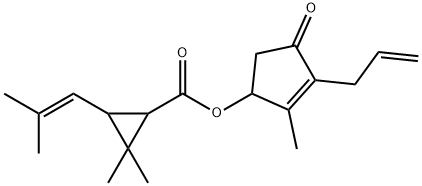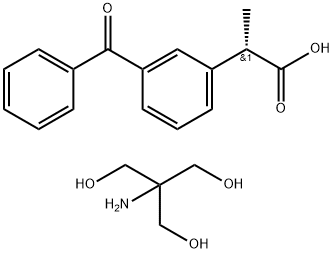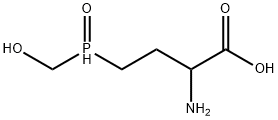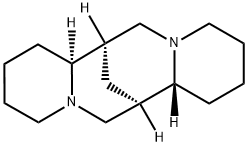Allethrin
Synonym(s):Allylcinerine
- CAS NO.:584-79-2
- Empirical Formula: C19H26O3
- Molecular Weight: 302.41
- MDL number: MFCD00045443
- EINECS: 209-542-4
- SAFETY DATA SHEET (SDS)
- Update Date: 2025-12-16 16:15:04

What is Allethrin?
Toxicity
Bioallethrin can produce hypersensitivity reactions in patients sensitive to ragweed or chrysanthemum . Ingestion of bioallethrin can produce life-threatening convulsions or coma. Less serious toxic effects include sore throat, nausea, vomiting, abdominal pain, mouth ulceration, increased secretions and/or dysphagia. Systemic effects include dizziness, headache and fatigue are common, and palpitations, chest tightness and blurred vision and occur 4-48 h after exposure.
Bioallethrin is not carcinogenic or mutagenic . In rats doses over 58.7 mg/kg/day produce reproductive effects and doses over 125 mg/kg/day are embryotoxic.
Rat
Rabbit
Chemical properties
Yellow Oil
The Uses of Allethrin
Allethrin is a synthetic pyrethroid derivative used as an insecticide. Allethrin is commonly used in many household insecticide products due to its low toxicity towards humans.
The Uses of Allethrin
The allethrins are used to control a wide range of insects in horticultural, household, public health and animal health situations. They have some limited use on ornamentals and vegetables (in combination with synergists).
The Uses of Allethrin
Esbiothrin may be used as a reference standard for the determination of the analyte in electric-mosquito coils using gas chromatography (GC) technique.
Background
Bioallethrin refers to a mixture of two of the allethrin isomers (1R,trans;1R and 1R,trans;1S) in an approximate ratio of 1:1, where both isomers are active ingredients. A mixture of the two same stereoisomers, but in an approximate ratio of R:S in 1:3, is called esbiothrin. A mixture containing only S-forms of allethrin is referred to as esbioallethrin or S-bioallethrin. Bioallethrin is a synthetic pyrethroid used as a pesticide against household pest insects such as mosquitoes, houseflies and cockroaches. It is claimed to have low mammalian toxicity.
Indications
Bioallethrin was used for lice and scabies infestation. Other pyrethroids are now used in place of bioallethrin.
What are the applications of Application
Allethrin is a synthetic compound that modulates sodium channels in the nerve cell membrane
Definition
Generic name for 2-allyl4-hydroxtcyclopenten-1-one ester of chrysanthemummonocarboxylic acid. A synthetic insecticide structurally similar to pyrethrin and used in the same manner. For other synthetic analogs, see barthrin, cyclethrin, ethythrin, furethrin. Pyrethrin I differs in having a 2,4-pentadienyl group in place of the allyl of allethrin.
General Description
A clear amber-colored viscous liquid. Insoluble and denser than water. Toxic by ingestion, inhalation, and skin absorption. A synthetic household insecticide that kills flies, mosquitoes, garden insects, etc.
Air & Water Reactions
Insoluble in water.
Reactivity Profile
Allethrin is an ester and ketone. Esters react with acids to liberate heat along with alcohols and acids. Strong oxidizing acids may cause a vigorous reaction that is sufficiently exothermic to ignite the reaction products. Heat is also generated by the interaction of esters with caustic solutions. Flammable hydrogen is generated by mixing esters with alkali metals and hydrides. Ketones are reactive with many acids and bases liberating heat and flammable gases (e.g., H2). The amount of heat may be sufficient to start a fire in the unreacted portion of the ketone. Ketones react with reducing agents such as hydrides, alkali metals, and nitrides to produce flammable gas (H2) and heat. Ketones are incompatible with isocyanates, aldehydes, cyanides, peroxides, and anhydrides. They react violently with aldehydes, HNO3, HNO3 + H2O2, and HClO4.
Health Hazard
Highly toxic, may be fatal if inhaled, swallowed or absorbed through skin. Avoid any skin contact. Effects of contact or inhalation may be delayed. Fire may produce irritating, corrosive and/or toxic gases. Runoff from fire control or dilution water may be corrosive and/or toxic and cause pollution.
Fire Hazard
Non-combustible, substance itself does not burn but may decompose upon heating to produce corrosive and/or toxic fumes. Containers may explode when heated. Runoff may pollute waterways.
Agricultural Uses
Insecticide: Allethrin is used almost exclusively to control flying and crawling insects in homes and industrial locations. Used extensively in pet animal shampoos, to treat lice in humans and in home and industrial sprays for flying insects, mosquitos, etc. It is available as mosquito coils, mats, oil formulations and as an aerosol spray. It may be hazardous to the environment; special attention should be given to fish and honey bees. Not currently registered in the U.S. Not approved for use in EU countries. Depending on CAS registry number there are probably >100 global suppliers.
Trade name
BIOALLETHRIN®; BIOALLETHRIN TECHNICAL®; d-CISALLETHRIN®; ESBIOTHRIN®; EXTHRIN® FMC 249®; NIA 249®; OMS 468®; PYNAMIN®; PYNAMIN-FORTE®; PYRESIN®; PYRESYN®; PYREXCEL®; PYROCIDE®; SBP 1382/ BIOALLETHRIN CONCENTRATE®
Contact allergens
Pyrethroids, also called pyrethrinoids, are neurotoxic synthetic compounds used as insecticides, with irritant properties. Cypermethrin and fenvalerate have been reported as causing positive allergic patch tests, but only fenvalerate was relevant in an agricultural worker.
Pharmacokinetics
Bioallethrin causes respiratory paralysis in lice and scabies parasites resulting in death .
Safety Profile
Poison by intravenous, intracerebral, and intraperitoneal routes. Moderately toxic by ingestion and skin contact. An allergen. An insecticide. It can cause liver and kidney damage by all routes of entry into the body. Lung congestion may occur due to exposure. Local contact may cause contact dermatitis. Inhalation may cause asthma, coughing, wheezing, running nose and eyes. Mutation data reported. See also ALLYL COMPOUNDS and ESTERS. Slight fire hazard. When heated to decomposition it emits acrid fumes.
Metabolic pathway
Allethrin was the first synthetic pyrethroid. Its stereochemistry is RS(cyclopentenyl)lRcis-trans. It was further developed as bioallethrin (RSlRtvuns) and then as S-bioallethrin (SlRtvuns), the most potent of the three. All are very sensitive to light and are used almost entirely indoors. Thus, there is only a limited amount of information on their environmental fate published in the literature. Information on photodegradation and on metabolism in insects and rodents has been reported.
Metabolism
Metabolism of bioallethrin in both rats and humans is considered to be virtually 100% oxidative . This is because bioallethrin is very resistant to hydrolysis of its ester group although a negligible amount of hydrolysis may occur.
In humans bioallethrin is metabolized primarily by CYP2C19 with some metabolism by CYP2C8, CYP3A4, and CYP2C9*2 . The metabolites produced include primary alcohols via allylic oxidation near the cyclopropane group and subsequent oxidation to carboxylic acid, formation of a primary alcohol via oxidation of a methyl group to located on the cyclopropane portion of the molecule, formation of a primary alcohol via allylic oxidation near the 5-membered ring or formation of an epoxide at this location and subsequent hydrolysis to a diol.
In rats bioallethrin has been found to be metabolized mainly by CYP2C6, CYP2C11, and CYP3A1 with some contribution from CYP1A1, CYP2A1 and CYP3A2 . Rats appear to metabolize bioallethrin at about 15 times the rate of humans.
Degradation
The allethrins are reasonably stable but they are sensitive to base
hydrolysis forming chrysanthemic acid (2) and 3-allyl-2-methyl-4-
oxocyclopent-2-enol(3, allethrolone). The DT50 of bioallethrin in aqueous
solution is 547 days at pH 7 and 4.3 days at pH 9.
The allethrins are also sensitive to oxidation and to photodecomposition.
Allethrin was converted almost quantitatively into the
cycloproprethronyl derivative (4) by a di-π-methane rearrangement on
irradiation in hexane solution (Bullivant and Pattenden, 1976). In
addition, isomerisation, oxidation and epoxidation of the isobutenyl
group of the chrysanthemic acid moiety by reactions analogous to those
described under phenothrin have been described (Ruzo et al., 1980).
Most products retained the ester linkage but the acid 2 was identified.
A novel product, 1-cyclopropyl-5-methyl-6-oxabicyclo[3.0.1]hexan-2-on-
4-yl chrysanthemate (5), was then reported (Kimmel et al., 1982). This
product proved to be a potent bacterial mutagen (Ames assay). Later
Isobe et al. (1984) reported photo-oxidation products derived from the
alcohol moiety: the alcohol (3) and allethronyl glyoxalate (6). The
latter was mostly present as its hydrate (7).T he ester (8) was also detected
but this was shown not to be a precursor of 6 or 7. These products
are illustrated in Scheme 1. Products formed by oxidation of the acid
moiety and retaining the ester link, such as 9, 10 and 11, are shown in
Scheme 2.
These two sites of weakness in allethrin render it one of the most photolabile
of the synthetic pyrethroids (Ruzo, 1982) and result in a complex
mixture of degradation products.
Properties of Allethrin
| Melting point: | approximate 4℃ |
| Boiling point: | 160°C |
| Density | 1.01 |
| vapor pressure | 1.6×10-4 Pa (21 °C) |
| refractive index | nD20 1.5040; nD30 1.5023 |
| Flash point: | 66 °C |
| storage temp. | 2-8°C |
| solubility | Chloroform: Slightly Soluble |
| form | Viscous Liquid |
| Water Solubility | 2 mg l-1 |
| color | Clear amber |
| BRN | 2294836 |
| CAS DataBase Reference | 584-79-2(CAS DataBase Reference) |
| NIST Chemistry Reference | Bioallethrin(584-79-2) |
| EPA Substance Registry System | Allethrin (584-79-2) |
Safety information for Allethrin
| Signal word | Warning |
| Pictogram(s) |
 Exclamation Mark Irritant GHS07  Environment GHS09 |
| GHS Hazard Statements |
H410:Hazardous to the aquatic environment, long-term hazard |
| Precautionary Statement Codes |
P273:Avoid release to the environment. |
Computed Descriptors for Allethrin
New Products
4,4-Difluoropiperidine hydrochloride tert-butyl 9-methoxy-3-azaspiro[5.5]undecane-3-carboxylate Indole Methyl Resin N-Isopropylurea N,N-Dicyclohexylcarbodiimide(DCC) MELDRUMS ACID 5-METHYLISOXAZOLE-4-CARBOXYLIC ACID Magnessium Bis glycinate Zinc ascorbate 1-bromo-2-butyne 2-acetamidophenol 9(10H)-anthracenone Erythrosin B, 4-Piperidinopiperidine 2-((4-morpholinophenylamino) (methylthio) methylene) malononitrile 2,4-dihydroxybenzaldehyde 3-(4-morpholinophenylamino)-5-amino-1H-pyrazole-4-carbonitrile Methyl 2-methylquinoline-6-carboxylate 2,6-dichloro-4-nitropyridine 4-Bromo-2-chlorobenzonitrile 2-(benzylamino)acetic acid hydrochloride 4-(tert-Butoxycarbonylamino)but- 2-ynoic acid 3,4-dihydro-2H-benzo[b][1,4]dioxepine 1-Phenyl-1-cycloprppanecarboxylicacidRelated products of tetrahydrofuran








You may like
-
 584-79-2 Allethrin 98%View Details
584-79-2 Allethrin 98%View Details
584-79-2 -
 584-79-2 98%View Details
584-79-2 98%View Details
584-79-2 -
 Allethrin 98%View Details
Allethrin 98%View Details
584-79-2 -
 Esbiothrin 97% (GC) CAS 584-79-2View Details
Esbiothrin 97% (GC) CAS 584-79-2View Details
584-79-2 -
 Allethrin CAS 584-79-2View Details
Allethrin CAS 584-79-2View Details
584-79-2 -
 Esbiothrin CAS 584-79-2View Details
Esbiothrin CAS 584-79-2View Details
584-79-2 -
 20677-73-0 (2,2-diethoxyethyl)methylamine 98%View Details
20677-73-0 (2,2-diethoxyethyl)methylamine 98%View Details
20677-73-0 -
 3-(4-(hydroxyamino)-1-oxoisoindolin-2-yl)piperidine-2,6-dione 98%View Details
3-(4-(hydroxyamino)-1-oxoisoindolin-2-yl)piperidine-2,6-dione 98%View Details
